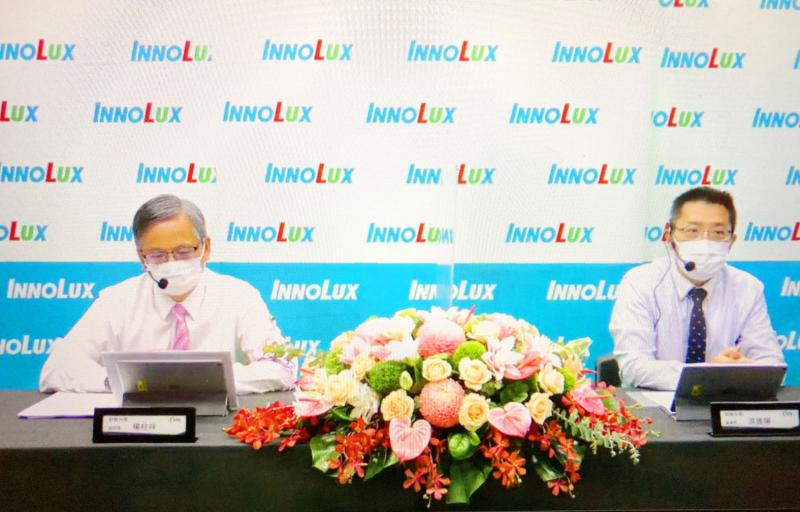LCD panel maker Innolux Corp (群創) yesterday said it was cautiously optimistic about second-half prospects as an imminent glass substrate supply constraint and an ongoing chip shortage would curb supply and avert a glut.
The supply of glass substrates might start declining this month at the earliest, as some manufacturers commence annual factory maintenance, the Miaoli-based company said.
“We believe this should help ease industry concern over a supply-demand imbalance as some capacities, which are used to make panels for monitors, notebooks or TVs, would be down,” Innolux president James Yang (楊柱祥) told an investors’ teleconference.

Photo: Lisa Wang, Taipei Times
The reduced supply would cut flat-panel production by about 360,000 units, Yang estimated, adding that a glass substrate supplier has said it plans to cut utilization by 15 to 20 percent.
Because of reduced glass substrate supply, “we are cautiously optimistic about the second-half market situation,” Yang said. “Market demand remains strong.”
Innolux forecast that shipments of panels for computers and TVs would grow by a low-single-digit percentage sequentially this quarter, benefiting from back-to-school and return-to-office demand for commercial laptops and monitors.
Average selling prices would climb by a low-single-digit percentage during the same period, it said.
Asked about Innolux’s long-term supply agreement with Chinese panel maker Sakai SIO International Guangzhou Co, company chairman Jim Hung (洪進揚) said the deal would boost the company’s output by about 2 to 3 percent next year.
Based on the agreement, Innolux would make a prepayment of 4 billion yuan (US$618.4 million) this year and next year to secure 65-inch and 75-inch TV panels from SIO’s G10.5 plant during the 2022-2033 period.
Innolux expects the strategic partnership to lift its profit margin, as G10.5 has a cost advantage over Innolux’s G6 and G8.5 factories in producing large TV panels, Hung said.
Innolux and local rival AU Optronics Corp (友達光電) do not operate G10.5 fabs, as the two have long decided that they would not join the capacity expansion race with Chinese rivals, but would rather focus on boosting their products added value.
Innolux’s net profit last quarter soared 85.13 percent to a record NT$21.42 billion (US$770.14 million).
That compares with earnings of NT$11.57 billion in the first quarter and losses of NT$5.78 billion a year earlier.
Gross margin rose to 33.1 percent last quarter, from 25.8 percent in the first quarter and 2.8 percent in the same period last year.
Revenue last month grew 35.6 percent to NT$32.25 billion, compared with NT$23.77 billion in July last year.
That represented a monthly increase of 2.3 percent from NT$31.51 billion, thanks to a 3.8 percent growth in shipments of small and medium-sized panels last month.
Shipments of panels for PCs and TVs contracted 2.3 percent month-on-month.

China’s Huawei Technologies Co (華為) plans to start mass-producing its most advanced artificial intelligence (AI) chip in the first quarter of next year, even as it struggles to make enough chips due to US restrictions, two people familiar with the matter said. The telecoms conglomerate has sent samples of the Ascend 910C — its newest chip, meant to rival those made by US chipmaker Nvidia Corp — to some technology firms and started taking orders, the sources told Reuters. The 910C is being made by top Chinese contract chipmaker Semiconductor Manufacturing International Corp (SMIC, 中芯) on its N+2 process, but a lack

TECH BOOST: New TSMC wafer fabs in Arizona are to dramatically improve US advanced chip production, a report by market research firm TrendForce said With Taiwan Semiconductor Manufacturing Co (TSMC, 台積電) pouring large funds into Arizona, the US is expected to see an improvement in its status to become the second-largest maker of advanced semiconductors in 2027, Taipei-based market researcher TrendForce Corp (集邦科技) said in a report last week. TrendForce estimates the US would account for a 21 percent share in the global advanced integrated circuit (IC) production market by 2027, sharply up from the current 9 percent, as TSMC is investing US$65 billion to build three wafer fabs in Arizona, the report said. TrendForce defined the advanced chipmaking processes as the 7-nanometer process or more

NVIDIA PLATFORM: Hon Hai’s Mexican facility is to begin production early next year and a Taiwan site is to enter production next month, Nvidia wrote on its blog Hon Hai Precision Industry Co (鴻海精密), the world’s biggest electronics manufacturer, yesterday said it is expanding production capacity of artificial intelligence (AI) servers based on Nvidia Corp’s Blackwell chips in Taiwan, the US and Mexico to cope with rising demand. Hon Hai’s new AI-enabled factories are to use Nvidia’s Omnivores platform to create 3D digital twins to plan and simulate automated production lines at a factory in Hsinchu, the company said in a statement. Nvidia’s Omnivores platform is for developing industrial AI simulation applications and helps bring facilities online faster. Hon Hai’s Mexican facility is to begin production early next year and the

Who would not want a social media audience that grows without new content? During the three years she paused production of her short do-it-yourself (DIY) farmer’s lifestyle videos, Chinese vlogger Li Ziqi (李子柒), 34, has seen her YouTube subscribers increase to 20.2 million from about 14 million. While YouTube is banned in China, her fan base there — although not the size of YouTube’s MrBeast, who has 330 million subscribers — is close to 100 million across the country’s social media platforms Douyin (抖音), Sina Weibo (新浪微博) and Xiaohongshu (小紅書). When Li finally released new videos last week — ending what has